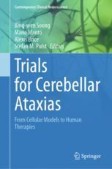Search
Search Results
-
Longitudinal investigation of brain activation during motor tasks in Friedreich ataxia: 24-month data from IMAGE-FRDA
Friedreich ataxia (FRDA) is a progressive autosomal recessive disease. While motor dysfunction is the primary neurological hallmark, little is known...

-
An RNA-seq study in Friedreich ataxia patients identified hsa-miR-148a-3p as a putative prognostic biomarker of the disease
Friedreich ataxia (FRDA) is a life-threatening hereditary ataxia; its incidence is 1:50,000 individuals in the Caucasian population. A unique...

-
The Role of Verbal Fluency in the Cerebellar Cognitive Affective Syndrome Scale in Friedreich Ataxia
Cerebellar pathology engenders the disturbance of movement that characterizes Friedreich ataxia (FRDA), yet the impact of cerebellar pathology on...

-
Therapeutic Use of Interferon Gamma in Friedreich Ataxia
Friedreich’s ataxia (FRDA) is a progressive neurodegenerative disorder caused by GAA triplet expansion in the FXN gene. At the cellular level, FRDA...
-
Patient-derived iPSC models of Friedreich ataxia: a new frontier for understanding disease mechanisms and therapeutic application
Friedreich ataxia (FRDA) is a rare genetic multisystem disorder caused by a pathological GAA trinucleotide repeat expansion in the FXN gene. The...

-
Prevalence and Diagnostic Journey of Friedreich’s Ataxia in the State of São Paulo, Brazil
Friedreich's Ataxia (FRDA) is the leading cause of ataxia worldwide, but data on epidemiology and diagnostic journey are scarce, particularly in...

-
Longitudinal Increases in Cerebral Brain Activation During Working Memory Performance in Friedreich Ataxia: 24-Month Data from IMAGE-FRDA
Friedreich ataxia (FRDA) has been associated with functional abnormalities in cerebral and cerebellar networks, particularly in the ventral attention...

-
The C-Terminal Cross-linked Telopeptide of Type I Collagen (CTX-I) as a Potential Cardiomyopathy Biomarker in Friedreich Ataxia Patients
Friedreich’s ataxia (FRDA) is the most common inherited recessive ataxia. Cardiomyopathy (CM) with myocardial hypertrophy is the predominant cause of...

-
State of the Art and History of Therapeutics in Ataxias
Research into novel therapeutics suggests that treatment of cerebellar ataxia may be attainable in the future. Recently, omaveloxolone, an NRF2...
-
Quantitative Oculomotor Assessment in Hereditary Ataxia: Discriminatory Power, Correlation with Severity Measures, and Recommended Parameters for Specific Genotypes
Characterizing bedside oculomotor deficits is a critical factor in defining the clinical presentation of hereditary ataxias. Quantitative assessments...

-
Therapeutic Biomarkers in Friedreich’s Ataxia: a Systematic Review and Meta-analysis
Although a large array of biomarkers have been investigated in Friedreich’s ataxia (FRDA) trials, the optimal biomarker for assessing disease...

-
Removal of the GAA repeat in the heart of a Friedreich’s ataxia mouse model using CjCas9
Most Friedreich ataxia (FRDA) cases are caused by the elongation of the GAA repeat (GAAr) sequence in the first intron of the FXN gene, leading to a...

-
Novel intragenic deletion within the FXN gene in a patient with typical phenotype of Friedreich ataxia: may be more prevalent than we think?
BackgroundFriedreich ataxia is the most common inherited ataxia in Europe and is mainly caused by biallelic pathogenic expansions of the GAA...

-
The Responsiveness of Gait and Balance Outcomes to Disease Progression in Friedreich Ataxia
To identify gait and balance measures that are responsive to change during the timeline of a clinical trial in Friedreich ataxia (FRDA), we...

-
Auditory Phenotypic Variability in Friedreich’s Ataxia Patients
Auditory neural impairment is a key clinical feature of Friedreich’s Ataxia (FRDA). We aimed to characterize the phenotypical spectrum of the...

-
The Cost of Living with Inherited Ataxia in Ireland
Inherited ataxias are a heterogenous group of neurodegenerative disorders characterised by progressive impairment of balance and coordination,...
-
Autosomal and X-Linked Degenerative Ataxias: From Genetics to Promising Therapeutics
Autosomal recessive cerebellar ataxias (ARCAs) refer to a large group of neurodegenerative disorders mainly affecting the cerebellum and the nervous...
-
Health-Related Quality of Life in Patients with Inherited Ataxia in Ireland
Inherited cerebellar ataxias (CA) are heterogeneous progressive neurological conditions associated with significant functional limitations. This...

-
A Milestone in the Treatment of Ataxias: Approval of Omaveloxolone for Friedreich Ataxia
The exciting news about the US FDA approval of omaveloxolone as the first-ever drug to be approved for an inherited ataxia is welcome news for...
-
Compound heterozygosity for an expanded (GAA) and a (GAAGGA) repeat at FXN locus: from a diagnostic pitfall to potential clues to the pathogenesis of Friedreich ataxia
Friedreich’s ataxia (FRDA) is usually due to a homozygous GAA expansion in intron 1 of the frataxin ( FXN ) gene. Rarely, uncommon molecular...

